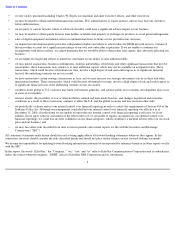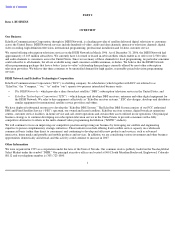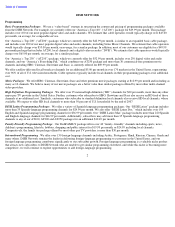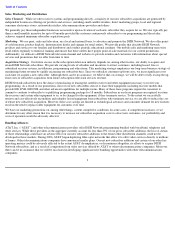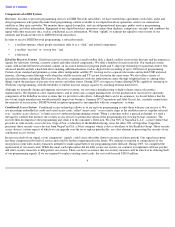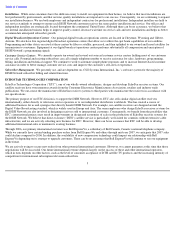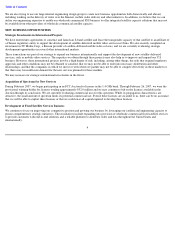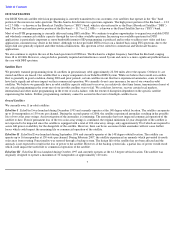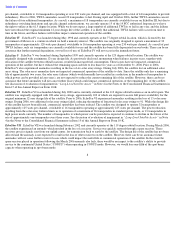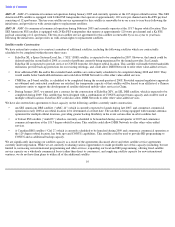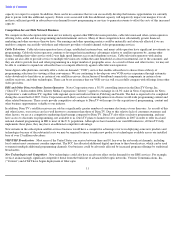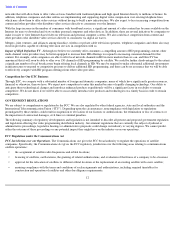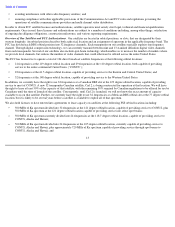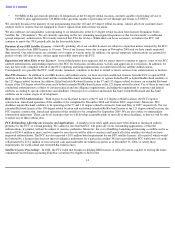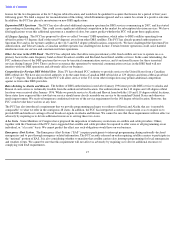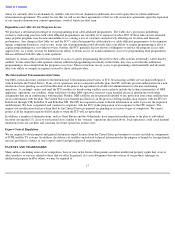Dish Network 2007 Annual Report Download - page 16
Download and view the complete annual report
Please find page 16 of the 2007 Dish Network annual report below. You can navigate through the pages in the report by either clicking on the pages listed below, or by using the keyword search tool below to find specific information within the annual report.
Table of Contents
EchoStar VIII
. EchoStar VIII was launched during August 2002 and currently operates at the 110 degree orbital location. The satellite was
designed to operate 32 transponders at approximately 120 watts per channel, switchable to 16 transponders operating at approximately 240
watts per channel. EchoStar VIII also includes spot-beam technology. As previously disclosed, the satellite has experienced several anomalies
since launch, but none have reduced the 12-year estimated useful life of the satellite. However, there can be no assurance that future anomalies
will not cause further losses which could materially impact its commercial operation, or result in a total loss of the satellite.
We depend on EchoStar VIII to provide service to CONUS at least until such time as our EchoStar XI satellite has commenced commercial
operation, which is currently expected during the second half of 2008. AMC-
14, which is expected to commence commercial operation in early
2008, also has the capability to act as a backup for EchoStar VIII and could be launched to the 110 degree orbital location, if necessary. In the
event that EchoStar VIII experienced a total or substantial failure, we could transmit many, but not all, of those channels from other in-orbit
satellites.
EchoStar IX
. EchoStar IX was launched during August 2003 and currently operates at the 121 degree orbital location. The satellite was
designed to operate 32 FSS transponders operating at approximately 110 watts per channel, along with transponders that can provide services
in the Ka-Band (a “Ka-band payload”). EchoStar IX provides expanded video and audio channels to DISH Network subscribers who install a
specially-designed dish. The Ka-band spectrum is being used to test and verify potential future broadband initiatives and to implement those
services. The satellite also includes a C-band payload which is owned by a third party. During the fourth quarter of 2006, EchoStar IX
experienced the loss of one of its three momentum wheels, two of which are utilized during normal operations. A spare wheel was switched in
at the time and the loss did not reduce the 12-year estimated useful life of the satellite. However, there can be no assurance future anomalies
will not cause further losses, which could impact the remaining life or commercial operation of the satellite.
EchoStar X
. EchoStar X was launched during February 2006 and currently operates at the 110 degree orbital location. Its 49 spot beams use
up to 42 active 140 watt TWTAs to provide standard and HD local channels, and other programming, to markets across the United States. In
the event our EchoStar X satellite experienced a significant failure, we would lose the ability to deliver local network channels in many
markets. While we would attempt to minimize the number of lost markets through the use of spare satellites and programming line up changes,
some markets would be without local channels until a replacement satellite with similar spot beam capability could be launched and
operational.
EchoStar XII
. EchoStar XII was launched during July 2003 and currently operates at the 61.5 degree orbital location. The satellite was
designed to operate 13 transponders at 270 watts per channel, in CONUS mode, or 22 spot beams using a combination of 135 and 65 watt
TWTAs. We currently operate the satellite in CONUS mode. EchoStar XII has a total of 24 solar array circuits, approximately 22 of which are
required to assure full power for the original minimum 12-year design life of the satellite. Prior to 2006, two solar array circuits failed, one of
which was subsequently restored to partial use. During 2006, three additional solar array circuits failed. The cause of the failures is being
investigated. While the design life of the satellite has not been affected, in future years the power loss will cause a reduction in the number of
transponders which can be operated. The exact extent of this impact has not yet been determined. There can be no assurance future anomalies
will not cause further losses, which could further impact commercial operation of the satellite or its useful life. See discussion of evaluation of
impairment in “ Long-Lived Satellite Assets ” in Note 4 in the Notes to the Consolidated Financial Statements in Item 15 of this Annual Report
on Form 10-K.
Leased Satellites
We currently lease three in-orbit satellites which are being used to provide, among other things, standard and HD programming to certain local
markets, international programming, backup capacity and fixed satellite service capacity on a wholesale commercial basis (rather than direct to
consumers).
AMC
-2 . AMC-2 currently operates at the 85 degree orbital location. This SES Americom FSS satellite is equipped with 24 medium power Ku
FSS transponders. Our lease of this satellite is expected to continue through 2007.
9



